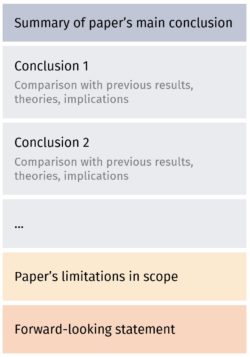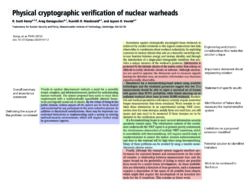The goal of the discussion is to synthesize, compare, and speculate based on your Results. A good Discussion section answers a broad set of questions to satisfy different audiences. The Discussion section will take different forms depending on the context and journal:
- It may be a stand-alone section
- It may be combined with the Results section
- It may split between your Results and Conclusions sections
1. Before you start
Often, people write by stream of consciousness: before they know where they want to go they just start writing. The result is a document that is hard to read for anyone but the writer. Thinking back to your Introduction puts your mind back into the big picture narrative where you started.
1.1. Reflect back on the Introduction
The Introduction and Discussion are natural partners: the Introduction tells the reader what question you are working on and why; the Discussion tells the reader how your results help answer the bigger question.
Imagine you explained the results in the paper to a labmate who looks confused and asks you, “Sure, but so what? Why was this cool or interesting?” Your response to your labmate should be similar to the content in the Discussion.
1.2. Analyze your audience
Different kinds of readers will expect different things from your Discussion. For example, non-experts might skip the Results, not wanting to learn to interpret them, and read the Discussion.
| Non-Expert Audience | General Technical Audience | Expert Audience |
| • What is unique and what are the implications?
• Where do we go from here? |
• How do your results fit into the broader scientific context?
• What were the limitations in your study? |
• How do you account for results that contradict the rest of the field?
• How do you explain confusing or complicated results? |
As you write your Discussion, decide who will find each paragraph interesting and what you want them to take away from it. Successful Discussions can simultaneously provide the specific, nuanced information that experts want to read and the broader, more general statements that non-experts can appreciate. The balance between expert and non-expert readers will depend on the journal you submit to. High-profile, general readership journals will have more non-expert readers, while more technical, field-specific journals can have almost exclusively expert readers.
2. Organize, outline, and go
The structure of your Discussion can vary greatly based on your targeted journal and narrative. In general, you will aim to have the following functional components.
 2.1. Layout the new conclusion
2.1. Layout the new conclusion
Start the Discussion with one or two sentences that state the main finding from the results and what that finding means for the field. Weak Discussions begin with a summary of the results or a repetition of the main points of the Introduction. Strong Discussions immediately carve out a place for themselves in the large universe of papers by saying what makes this one interesting or special.
2.2. How does it fit into the broader scientific context?
In the Introduction, you helped motivate your study by citing previous results in your field. Now that you’ve laid out your results, you should discuss whether your results agree or disagree with prior work and why. You might have extended previous work, showed how apparently conflicting results are actually harmonious, or exposed a contradiction that currently has no explanation.
2.3. Include a forward-looking statement
Explain how your study’s limitations leave open the big questions. Every study is finite: you did some things and not others, and you used methods that can explain some phenomena but not others. How do the limitations of your study leave open the bigger questions? Do you just need to do more of the same kind of work? Have you shown that current methods are inadequate to answering the big question?
Every paper is a contribution to a larger scientific conversation. Hopefully, you think your contribution is somehow useful to that conversation: it provides new information or tools that will help you or other researchers move toward answers to the big questions. To explain this contribution, many Discussions end with a forward-looking statement that tries to place the paper in an expected future of research in that field.
3. What if the journal doesn’t call for an explicit Discussion section?
Every journal has its own unique style (and every advisor has their own), so spend some time investigating what is typical in your field. Also, the sections described here may not be appropriate for the data/results you are planning to present. Perhaps you developed a new method, and in this case your method and its value are the central theme of the article, not a necessarily a new result or conclusion. Make sure that you choose the divisions in your paper to match what you are writing, and don’t confine yourself to Introduction/Methods/Results/Conclusions if it doesn’t make sense for your paper.
4. Criteria for success
As you iterate on your writing, make sure that your Discussion section does the following:
- Presents the main conclusion of the paper in one or two sentences.
- Describes how the paper’s results help answer the big questions posed in the Introduction.
- Explains how (and why) this work agrees or disagrees with other, similar work.
- Explains how the limitations of this study leave the some questions unanswered.
- Extrapolates how extensions of your results will be useful for answering the big questions.
5. Annotated examples
 |
To get started or receive feedback on your draft, make an appointment with us. We’d love to help!
